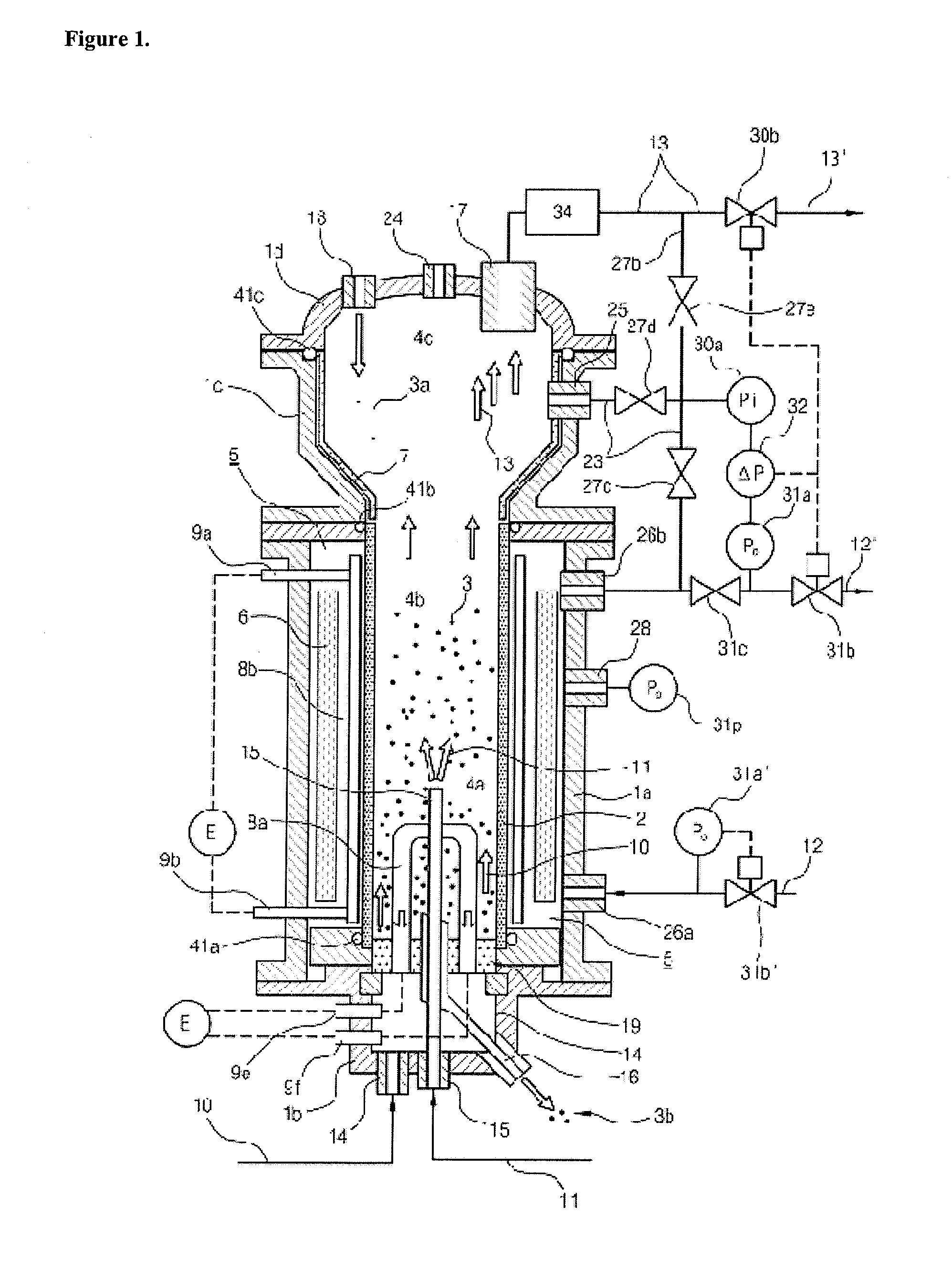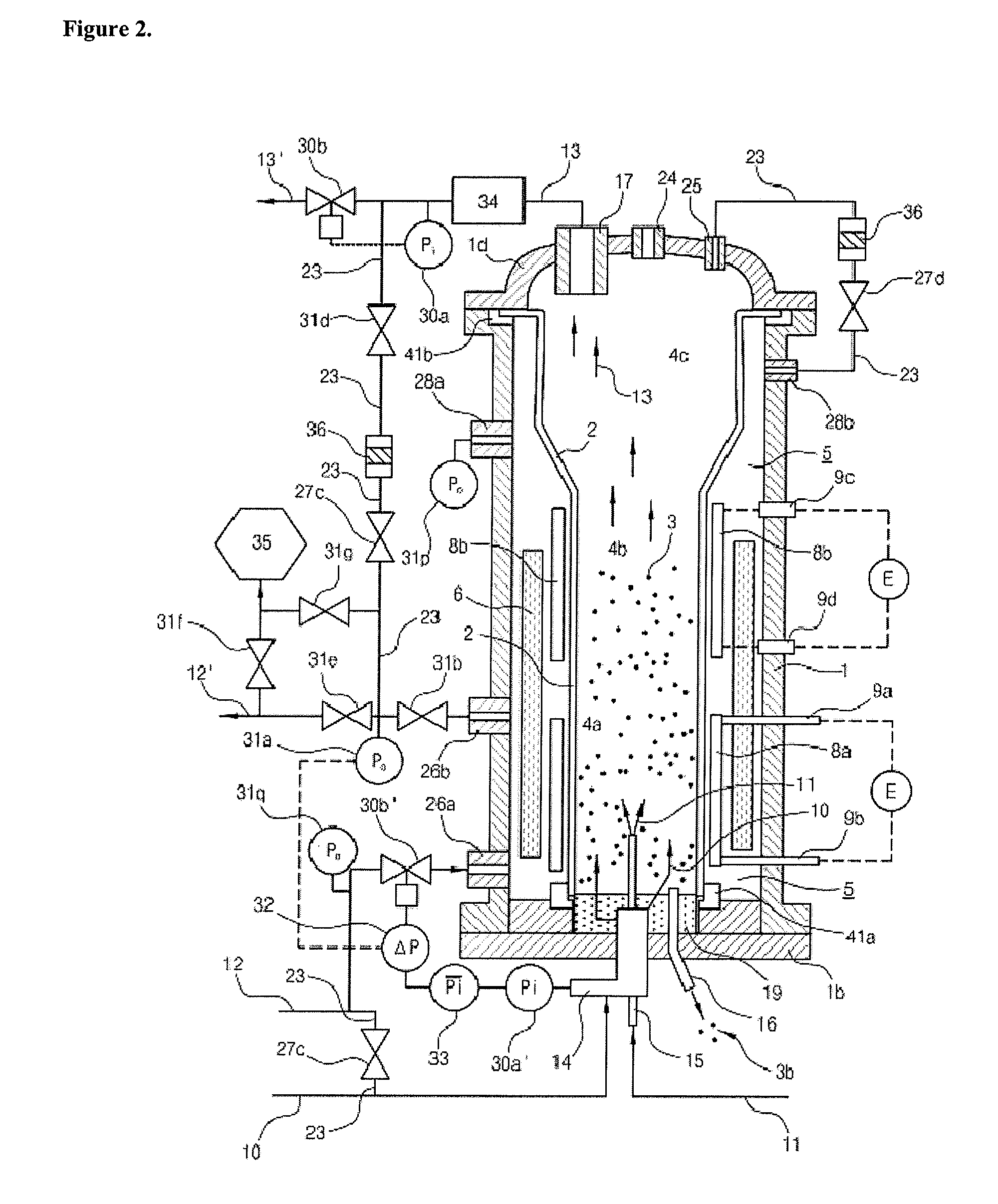High-pressure fluidized bed reactor for preparing granular polycrystalline silicon
a technology of fluidized bed reactor and granular polycrystalline silicon, which is applied in the direction of gas-gas reaction process, furnace, instruments, etc., can solve the problems of low deposition efficiency and high electrical energy consumption, the bell-jar type reactor, and the fundamental electric resistance heating system cannot be continuously operated, etc., to achieve the effect of reducing the fluidity of the reactor, reducing the fluidity, and reducing the fluidity
- Summary
- Abstract
- Description
- Claims
- Application Information
AI Technical Summary
Benefits of technology
Problems solved by technology
Method used
Image
Examples
example 1
[0167]Hereunder is provided a description of one embodiment where the inner pressure (Pi) and the outer pressure (Po) are independently controlled at predetermined values, Pi* and Po*, respectively, and the difference between the values of the inner pressure and the outer pressure is thereby maintained within the range of 0 to 1 bar.
[0168]As illustrated in FIGS. 1 and 2, an inner pressure controlling means 30 may be constituted by interconnecting a first pressure control valve 30b with a gas outlet means 17 through an off-gas treating means 34 for removing fine silicon particles, which are interconnected with each other by a connecting pipe. The pressure of the upper part of the inner zone 4 may be controlled at a predetermined value, Pi*, by using the first pressure control valve 30b which behaves as an element of a pressure-difference controlling means.
[0169]Meanwhile, as illustrated in FIG. 1, an outer pressure controlling means 31 may be constituted by interconnecting an inert g...
example 2
[0174]Hereunder is provided a description of another embodiment where the inner pressure (Pi) and the outer pressure (Po) are independently controlled at the predetermined values, Pi* and Po*, respectively, and the difference between the values of the inner pressure and the outer pressure is thereby maintained within the range of 0 to 1 bar.
[0175]As illustrated in FIGS. 1 and 2, an inner pressure controlling means 30 may be constituted by interconnecting a first pressure control valve 30b with the gas outlet means 17 through the off-gas treating means 34 for removing fine silicon particles, which are interconnected with each other by a connecting pipe. The pressure of the upper part of the inner zone 4 may be controlled at a predetermined value, Pi*, by using the first pressure control valve 30b which behaves as an element of a pressure-difference controlling means.
[0176]Meanwhile, as illustrated in FIG. 1, an outer pressure controlling means 31 may be constituted by interconnecting...
example 3
[0182]Hereunder is provided a description of one embodiment where the inner pressure (Pi) is controlled according to the change of the outer pressure (Po), and the difference between the values of the inner pressure and the outer pressure is thereby maintained within the range of 0 to 1 bar.
[0183]As illustrated in FIGS. 1 and 2, a gas outlet means 17, an off-gas treating means 34 for removing fine silicon particles and a first pressure control valve 30b are interconnected with each other by a connecting pipe. Then an inner pressure controlling means 30 may be constituted by interconnecting the connecting pipe with an on / off valve 27e and a pressure-difference gauge 32.
[0184]Meanwhile, as illustrated in FIG. 1, an outer pressure controlling means 31 may be constituted by interconnecting an inert gas connecting means 26b and a pressure-difference gauge 32, which are interconnected with each other by the connecting pipe. Here an inert gas 12 may be supplied to the outer zone through an...
PUM
| Property | Measurement | Unit |
|---|---|---|
| pressure | aaaaa | aaaaa |
| pressure | aaaaa | aaaaa |
| size | aaaaa | aaaaa |
Abstract
Description
Claims
Application Information
 Login to View More
Login to View More - R&D
- Intellectual Property
- Life Sciences
- Materials
- Tech Scout
- Unparalleled Data Quality
- Higher Quality Content
- 60% Fewer Hallucinations
Browse by: Latest US Patents, China's latest patents, Technical Efficacy Thesaurus, Application Domain, Technology Topic, Popular Technical Reports.
© 2025 PatSnap. All rights reserved.Legal|Privacy policy|Modern Slavery Act Transparency Statement|Sitemap|About US| Contact US: help@patsnap.com


